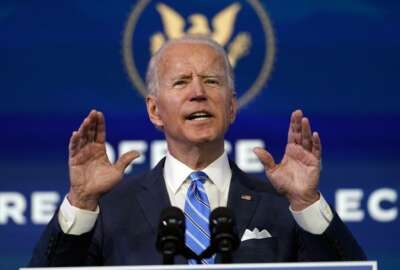
Money for IT modernization is available, if you know where to find it
Mark Forman, the former administrator for e-government and IT at OMB and Gloria Parker, a former CIO at HUD, helped author a new white paper from the Partnershi...
While Congress debates more funding for IT modernization, a group of CIO “gray beards” detail how current agency technology leaders can use existing policies and funding to accelerate modernization and digital transformation.
The Partnership for Public Service’s chief information officers’ SAGE program details how current agency technology leaders can use existing policies and funding to accelerate modernization and digital transformation.
Mark Forman, the former administrator for e-government and IT at OMB, said there are three ways agencies can invest in new technologies without having to ask for or wait for Congressional funding.

“One is focusing on agency priority goals. As the result of the pandemic, everybody working from home, there are certain things that have become barriers to being able to process the work of the government. Things like moving to digital signatures is a common one that I think people hear about. But it’s kind of an anathema to me, because one of the first tasks I had when I came into OMB 19 years ago was to make sure the Paperwork Elimination Act gets implemented. One of the key parameters was allowing for digital signature, a lot of agencies never integrated that in their legacy processes. Then you added security threats, you add in other aspects that you could say would be operation and maintenance (O&M). But really, the technology is such that if you leverage today’s technology that’s much more secure, that you create money for O&M,” Forman said on Ask the CIO.
Forman said there are three paths within the agency priority goals to find funding.
“Number one is the traditional path of agency, which now are agency priority goals. There’s a program that’s underperforming, it’s necessary either for pandemic response or the restructuring that occurs so this will never happen again, or for the economic stimulus programs, and the issues of the IGs have been identifying with that. And we know, in this next phase of picking up the pieces after the triage that was done immediately after the pandemic, there are going to be gaps and agencies will have to invest in it. Tying that investment — not anecdotes, but specific metrics tied to either the outgoing Trump administration or the incoming Biden administration priority goals — is path one, but it requires clear line of sight to how the investment drives the benefits,” he said.
Evidence-based policy making is a start
Forman said the second path for CIOs is to make better use of the Evidence-Based Policymaking Act and their data action plans.
“For most agencies there is a mix of experimentation and new data collection efforts or changes in program decision making. That requires systems. So I think there’s a natural linkage, but the people working on evidence-based policymaking don’t seem to partner up with CIOs. So that’s the path that CIOs have to engage with the people doing the evidence-based policymaking learning agenda,” he said. “The third place is 21st century IDEA Act. We know as a result of this movement to basically the workforce and business processes being online, there needs to be changes in user experience, both inside the government and with the state and local governments. As these delivery processes move online, this is not outside of the CIO, just a piece within the CIO organization. This needs to be a core area that they look at for modernization, leveraging, what is a Circular A-11 for 21st Century IDEA Act.”
Forman readily admits these ideas are not new or different. He said the SAGE group just wanted to remind the audience and offer some insights about these approaches in the call to action white paper, Transforming Government to a Post COVID-19 World. The paper also includes a government funding playbook, human capital management policies and how to identify and enable IT improvements.
Gloria Parker, the former CIO at the Department of Housing and Urban Development and now the president and CEO of Parker Group Consulting, said the SAGE community thought the time was right to offer some insights as the new administration comes into office and CIOs have the opportunity to build on the IT modernization successes of the pandemic.

“It’s not as intuitive as it would seem to be to some of us who might be standing on the outside looking in and had been there for a while. And on the inside, we know people are running and trying to put out fires and keep the lights on,” she said.
Agencies have been struggling to get out from under the technical debt for the better part of the last 15 years. After the hack suffered by the Office of Personnel Management in 2015, OMB estimated agencies had $7 billion in technical debt. Six years later, the pandemic and recently SolarWinds had driven home that need in a bigger and more real way.
This is why the Biden administration is proposing $10 billion for IT modernization and cybersecurity improvements.
While it’s still unclear how lawmakers will fund IT and cyber modernization, 12 industry associations are encouraging Congress to pay closer attention.
They wrote to lawmakers on Feb. 2 emphasizing why $9 billion for the Technology Modernization Fund and relieving a majority of the payback requirement is important.
“[F]ederal agencies still rely on many outdated and legacy IT systems and paper-based processes that have hampered the effectiveness of government operations and mission delivery,” the associations wrote. “Updating these systems is not only critical to improving access to services but also to ensuring those who are most in need of government assistance receive the emergency funding Congress has appropriated.”
O&M vs. DME
Forman and other experts say even if Congress comes through with a major funding increase, there still are ways to shift money from O&M to development, modernization and enhancement (DME).
“The question really is, are the CIOs going to focus more on their infrastructure and O&M in their production environment, for example? Or are they going to make the shift over to working with programs that have needs for modernization? And on the program side, are they going to work with their CIOs to engage in the modernization discussions, or they’re going to work with their historical vendors?” Forman asked. “The CIO role has largely been to deliver on that 80-85% which is of the IT spend, which is O&M. So how do you get them to shift to that other area of DME? Well, if you look at the IT dashboard, you see a slow growth in this concept of mixing development modernization enhancement with O&M. And it’s kind of tweaking at the edges. I think the difference today is because of the pandemic with a movement of people online, a lot more work has to go into how do you take advantage of a digital operating model in these agencies. Some of the CIOs, through FITARA, have been partnering up to do budget reviews. There’s a difference between being part of building a business case in a transformation initiative, and approving a business case. And what we’re saying is, CIOs, given the crisis that’s underway, you have to shift your focus now and get involved in building the business cases for transformation and building those investment concepts, partnering with the programs as opposed to just overseeing them.”
Park said connecting mission and technology comes back to the concept of an enterprise architecture.
She said it’s a matter of collecting and analyzing the data to understand how it all fits together.
“If the CIOs are talking regularly with the mission leaders at an agency, they can find the money. I think there’s more money that will be available coming out of the mission side as a result of a pandemic to begin to do some of the development work, some of the modernization that needs to be done,” Parker said. “Coming out of my past with the private sector where we had to always justify costs with our customers, that’s where the government needs to get to. They have to do a cost benefit analysis on the monies that they are asking for and how it’s going to be spent and what benefits are coming from it. When you do a complete cost-benefit analysis, you’re going to always find savings otherwise, there’s no need to spend the money. So I think that if CIOs can work with the mission folks, and really understand the business, understand what these applications of technology and these new developments monetization is going do, to increase their productivity and decrease their costs.”
Copyright © 2024 Federal News Network. All rights reserved. This website is not intended for users located within the European Economic Area.
Jason Miller is executive editor of Federal News Network and directs news coverage on the people, policy and programs of the federal government.
Follow @jmillerWFED






